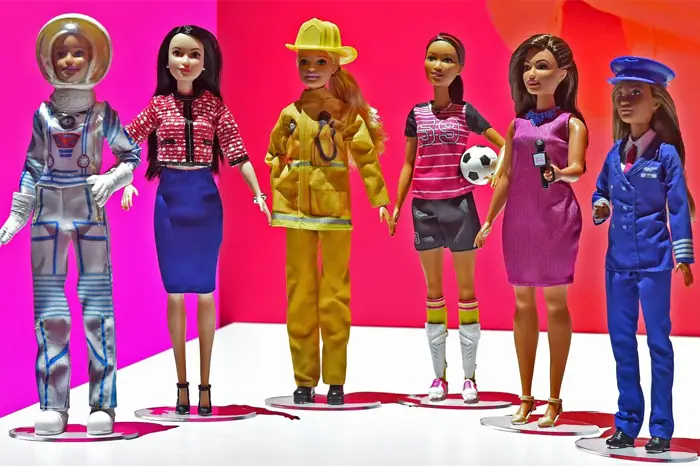 Ruth Handler watched her daughter Barbara at play with paper dolls, and noticed that she often enjoyed giving them adult roles. At the time, most children’s toy dolls were representations of infants. Realizing that there could be a gap in the market, she suggested the idea of an adult-bodied doll to her husband Elliot, a co-founder of the Mattel toy company. He was unenthusiastic about the idea, as were Mattel’s directors.
Ruth Handler watched her daughter Barbara at play with paper dolls, and noticed that she often enjoyed giving them adult roles. At the time, most children’s toy dolls were representations of infants. Realizing that there could be a gap in the market, she suggested the idea of an adult-bodied doll to her husband Elliot, a co-founder of the Mattel toy company. He was unenthusiastic about the idea, as were Mattel’s directors.
During a trip to Germany in 1956 with her children Barbara and Kenneth, Ruth Handler discovered a German doll called the Bild Lilli doll in a shop window. The adult-figured Lilli doll was exactly what Handler had in mind, so she purchased three of them. She gave one to her daughter and took the others back to Mattel. The Lilli doll was based on a popular character appearing in a comic strip drawn by Reinhard Beuthin for the newspaper Die Bild-Zeitung. Lilli was a working girl who knew what she wanted and was not above using men to get it. The Lilli doll was first sold in Germany in 1955, and although it was initially sold to adults, it became popular with children who enjoyed dressing her up in outfits that were available separately. On her return to the United States, Handler reworked the design of the doll (with help from engineer Jack Ryan) and the doll was given a new name, Barbie, after Handler’s daughter Barbara. The doll made its debut at the American International Toy Fair in New York on March 9, 1959. This date is also used as Barbie’s official birthday. Mattel acquired the rights to the Bild Lilli doll in 1964 and production of Lilli was stopped. The first Barbie doll wore a black and white zebra striped swimsuit and signature topknot ponytail, and was available as either a blonde or brunette. The doll was marketed as a “Teen-age Fashion Model”, with her clothes created by Mattel fashion designer Charlotte Johnson. Barbie’s appearance has been changed many times, most notably in 1971 when the doll’s eyes were adjusted to look forwards rather than sideways. Barbie was one of the first toys to have a marketing strategy based extensively on television advertising, which has been copied since by many other toys. Today the Barbie doll is a $1.9 billion a year industry, with Mattel claiming that three Barbie dolls are sold every second. Barbie products include not only the range of dolls with their clothes and accessories, but also a huge range of Barbie branded goods such as books, fashion items and video games. Barbie has appeared in a series of animated films and makes a brief guest appearance in the 1999 film Toy Story 2. Almost uniquely for a toy fashion doll, Barbie has become a cultural icon and has been given honors that are rare in the toy world. In 1974 a section of Times Square in New York City was renamed Barbie Boulevard for a week, while in 1985 the artist Andy Warhol created a painting of Barbie.

